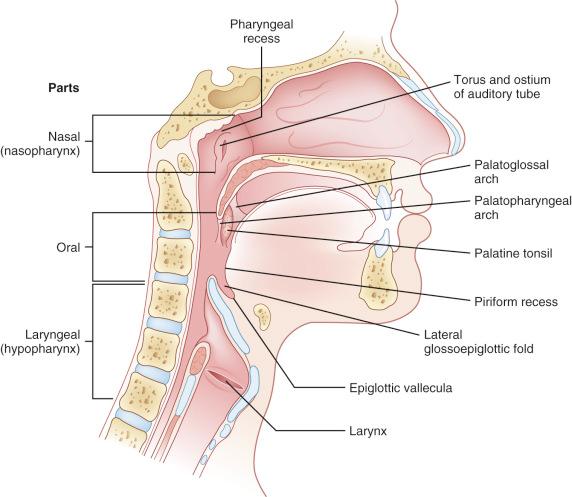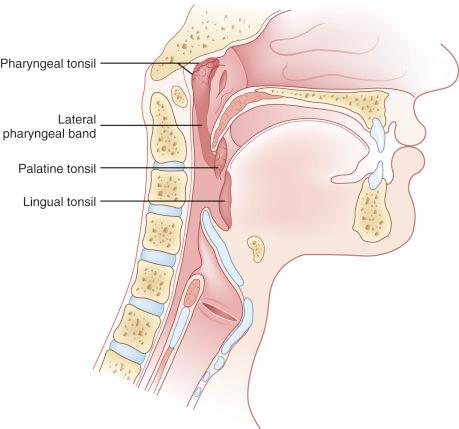Physical Address
304 North Cardinal St.
Dorchester Center, MA 02124
12- to 14-cm long musculomembranous tube shaped like an inverted cone
Extends from the cranial base to the lower border of the cricoid cartilage (level of the sixth cervical vertebra)
Limited superiorly by the posterior part of the body of the sphenoid and basilar part of the occipital bone and inferiorly with the esophagus, to which it is continuous
Lies behind and communicates with the nasal, oral, and laryngeal cavities via the nasopharynx, oropharynx, and hypopharynx (laryngopharynx), respectively; on this basis the pharynx is divided into three anatomic divisions including (from superior to inferior): ( Fig. 8-1 )
Nasopharynx
Oropharynx
Hypopharynx:
Often included as part of the larynx but given differences in embryology from the larynx (see Section 5) and the inclusion of hypopharyngeal cancers in the AJCC staging of pharyngeal cancers and not laryngeal cancers, the hypopharynx including the piriform sinus is included in this section on the Pharynx rather than in Section 5, Larynx.

Pharyngeal lining mucosa is continuous with the mucosa lining the nasal cavity, oral cavity, pharyngotympanic (eustachian) tubes, and larynx.
Primitive pharynx is derived from the foregut developing from the branchial arches and pharyngeal pouches:
Epithelium and glands are of endodermal derivation.
Tonsils develop from the second pharyngeal pouch.
Tubotympanic recess (forms the eustachian tube and tympanic cavity) develops from the first pharyngeal pouch.
Lymphoid tissues of the pharynx, including adenoids (pharyngeal tonsil), lateral pharyngeal lymphoid bands, and lingual and palatine tonsils, arise from pharyngeal endoderm.
Constrictor muscles derived from the fourth and sixth branchial arch
Nasopharyngeal tonsils (adenoids) lie along the posterior and lateral aspects of the nasopharynx.
Orifice of eustachian tube lies along the lateral aspects of the nasopharyngeal wall.
Soft palate
Base of tongue, including the lingual tonsils
Tonsillar pillars
Palatine tonsils
Posterior tonsillar pillars
Uvula
Waldeyer tonsillar ring ( Fig. 8-2 ) is formed by a ring or group of extranodal lymphoid tissues about the upper end of the pharynx, which consists of the:
Palatine tonsils
Pharyngeal tonsils (adenoids)
Base of tongue/lingual tonsils
Adjacent submucosal lymphatics

Become a Clinical Tree membership for Full access and enjoy Unlimited articles
If you are a member. Log in here